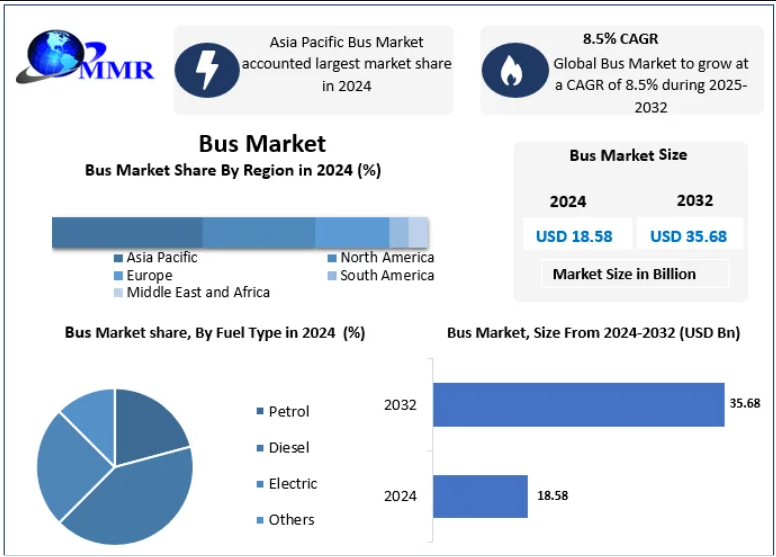Bus Market Size, Share, and Growth Forecast 2025–2032

Global Bus Market: Growth, Trends, Key Drivers, and Forecast (2025–2032)
The Bus Market size was valued at USD 18.58 billion in 2024 and is projected to reach USD 35.68 billion by 2032, expanding at a CAGR of 8.5% during the forecast period. The market is witnessing strong growth driven by rapid urbanization, rising environmental concerns, and increasing government investments in public transportation infrastructure.
Bus Market Overview
The global bus industry plays a vital role in urban mobility, school transportation, intercity travel, and tourism. Growing populations and rising urban congestion have accelerated the shift toward mass transit solutions. Governments worldwide are prioritizing public transport expansion, low-emission mobility, and sustainable infrastructure development.
The market report highlights comprehensive segment-wise and region-wise dynamics, covering growth drivers, restraints, opportunities, and upcoming challenges.
Click here to claim your free sample report and uncover the most lucrative market segments: https://www.maximizemarketresearch.com/request-sample/211011/
Bus Market Dynamics
1. Increasing Investments in Bus Infrastructure
Bus transport is significantly more cost-effective than rail infrastructure, leading to growing government and private investments. Multiple urban development programs are focusing on modern bus fleets and upgraded facilities.
- Proterra recently secured USD 200 million from Cowen Sustainable Advisors and other major investors.
- Investments in bus depots, smart terminals, and EV charging stations are accelerating globally.
Sky Bus and Suspended Monorail Innovations
India initiated an ambitious Sky Bus project in Goa worth USD 11.99 million, linking Mapusa to Panaji with a 10.5 km stretch.
Globally, suspended monorail systems operate in Japan, China, Germany, and the USA, indicating how advanced mobility technologies will support the bus industry in future decades.
2. Rising Demand for Electric Buses
Electric buses represent the fastest-growing segment of the market.
Key Growth Factors
- Lower operating cost
- Reduced maintenance
- Zero tailpipe emissions
- Government subsidies, grants, tax benefits
- Improved passenger comfort and low noise levels
By 2030, several countries aim to convert a significant share of their public transportation fleets to electric.
Industry Insight
- By April 2022, NFI Group Inc. recorded a massive backlog of 8,908 vehicles (valued at USD 4.9 billion), with 17% being electric buses.
- Zero-emission buses accounted for 43% of active bids.
3. Growing Private Demand
Although slower compared to public procurement, private demand is rising in:
- Corporate employee transportation
- Tourism and charter services
- Airport shuttle operations
- Luxury and specialty buses for events
This segment will grow steadily due to increasing business travel and hospitality expansion.
4. Market Restraints
Traffic Congestion
Urban congestion reduces bus speed and reliability, discouraging ridership. Poor quality bus stops, terminals, and depots also limit adoption.
Fuel Price Fluctuations
Volatile fuel costs affect operator margins, hindering investments in modernization.
Regional Insights
Asia Pacific – Largest Regional Market (2024)
Asia Pacific leads the global bus market thanks to:
- Massive population base
- Rapid urbanization
- Government EV initiatives
- Expanding transportation networks
Country Highlights
- China: Dominated by giants like BYD, Yutong, King Long
- India: Strong presence of Tata Motors, Ashok Leyland, Mahindra, growing demand for school and intercity buses
- South Korea: Focus on fuel-efficient, eco-friendly buses
Europe – Strong Regulatory Push Toward Clean Mobility
Europe has a well-established public transport system and strict emission regulations (Euro standards). Demand for electric and hybrid buses is rising rapidly.
- Germany leads regional sales with diverse bus applications including city, intercity, and coach buses.
North America – Fastest-Growing Electric Bus Market
North America is witnessing a major shift toward electric school buses and clean transit fleets.
- Greyhound, North America's largest intercity network, connects 2,300+ destinations, boosting overall mobility demand.
- By 2022, 415 U.S. school districts committed to 12,275 electric school buses across 38 states.
CNG and propane-powered buses are also popular due to low emissions and cost benefits.
Click here to claim your free sample report and uncover the most lucrative market segments: https://www.maximizemarketresearch.com/request-sample/211011/
Bus Market Segment Analysis
By Type
- Transit Bus (Dominant Segment)
Rising urbanization and government funding for sustainable mobility are expanding this segment. - School Bus
- Coach/Intercity Bus
- Shuttle Bus
- Others
Real-time tracking systems, digital ticketing, and passenger comfort enhancements are major drivers of the transit bus segment.
Competitive Landscape
The market is moderately consolidated, with global and regional players expanding through partnerships, acquisitions, and technology collaborations.
Key Growth Strategies
- Joint ventures with battery and EV component suppliers
- Development of autonomous and connected bus technologies
- Cross-regional fleet expansion
- Public transport agency partnerships
Notable Developments
- Proterra & LG Energy Solutions (2021): Battery supply collaboration
- Volvo Buses: Partnerships for autonomous and electric buses
- Proterra & Miami-Dade Transit (2021): Fleet modernization project
- BYD & Castrosua (2023): Launch of jointly manufactured eBus in Europe
Key Players in the Global Bus Market
- Ashok Leyland
- Tata Motors Limited
- BYD Company Limited
- Yutong Bus Co., Ltd.
- Alexander Dennis
- Daimler Truck Holding AG
- Volvo Bus Corporation
- Solaris Bus & Coach
- NFI Group Inc.
- King Long United Automotive
- Mahindra & Mahindra
- Proterra
- Zhongtong Bus
- VDL Bus & Coach
- Irizar Group
- Otokar
- Temsa
- Traton Group (Volkswagen AG)
- SML ISUZU Ltd.
- Ebusco
- JBM Group
- Suzhou Eagle Electric
- Others
Conclusion
The global Bus Market is undergoing a transformative shift driven by sustainability, electrification, innovative technologies, and expanding public transportation needs. With strong government support and continuous technological upgrades, the industry is expected to achieve robust growth through 2032.
- Art
- Causes
- Crafts
- Dance
- Drinks
- Film
- Fitness
- Food
- Игры
- Gardening
- Health
- Главная
- Literature
- Music
- Networking
- Другое
- Party
- Religion
- Shopping
- Sports
- Theater
- Wellness


